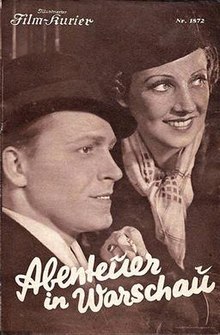This article needs additional citations for verification .(June 2021) |
| Adventure in Warsaw | |
|---|---|
 | |
| Directed by | Carl Boese |
| Written by | |
| Starring | |
| Cinematography | Georg Krause |
| Music by | Michael Jary |
Production companies |
|
| Distributed by | Tobis Film |
Release date |
|
| Countries |
|
| Language | German |
Adventure in Warsaw (German : Abenteuer in Warschau) is a 1938 German-Polish comedy film directed by Carl Boese and starring Georg Alexander, Paul Klinger and Jadwiga Kenda. The film was the second of two German-Polish co-productions following Augustus the Strong (1936). [1]
Contents
A separate Polish version A Diplomatic Wife was released.